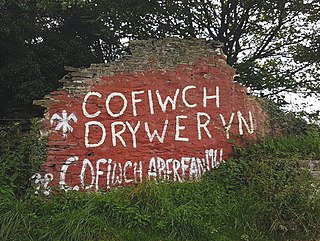
Gwynfor Richard Evans was a Welsh politician, lawyer and author. He was President of the Welsh political party Plaid Cymru for thirty-six years and was the first member of Parliament to represent it at Westminster, which he did twice, from 1966 to 1970, and again from 1974 to 1979.

Trawsfynydd is a linear village in Gwynedd, Wales, near Llyn Trawsfynydd reservoir, and adjacent to the A470 north of Bronaber and Dolgellau and 10 km south of Blaenau Ffestiniog. It also neighbours the towns of Porthmadog and Bala.

Bala is a town and community in Gwynedd, Wales. Formerly an urban district, Bala lies in the historic county of Merionethshire, at the north end of Bala Lake. According to the 2021 Census, Bala had a population of 1,999 and 72.5 per cent of the population could speak Welsh with a decrease of 6% since 2011.

The Tryweryn is a river in the north of Wales which starts at Llyn Tryweryn in the Snowdonia National Park and after 19 kilometres (12 mi) joins the river Dee at Bala. One of the main tributaries of the Dee, it was dammed in 1965 to form Llyn Celyn. The Tryweryn flooding forcibly removed residents of the village of Capel Celyn despite popular and political opposition in Wales. The resulting graffiti "Cofiwch Dryweryn" near Llanrhystud became and remains a popular icon of Welsh feeling. Water is stored in Llyn Celyn in winter when flows are high, and released over the summer to maintain the flow in the Dee (water from the Dee is used as the water supply for large areas of north-east Wales, and for the Wirral and much of Liverpool in England.
The Dee regulation scheme is a system of flow balancing and quality management along the River Dee managed by a consortium of the three largest water companies licensed to take water from the river, United Utilities, Welsh Water and Severn Trent Water; together with the regulator, Natural Resources Wales.
Mudiad Amddiffyn Cymru, abbreviated as MAC, was a paramilitary Welsh nationalist organisation, which was responsible for a number of bombing incidents between 1963 and 1969. The group's activities primarily targeted infrastructure carrying water to the English city of Liverpool.

Llyn Celyn is a reservoir constructed between 1960 and 1965 including the highly controversial Tryweryn flooding in the valley of the River Tryweryn in Gwynedd, Wales. This included the forcible removal of the Capel Celyn village residents despite protest and opposition of Welsh MPs.

Llyn Brenig is a reservoir located on Denbigh Moors in North Wales. The artificial lake, which was constructed between 1973 and 1976, was created by building an embankment dam across the Afon Brenig valley. It lies at 1,200 ft (370 m) above sea level on the border between the counties of Conwy and Denbighshire. It is used to manage the flow in the River Dee as part of the River Dee regulation system.

Plaid Cymru originated in 1925 after a meeting held at that year's National Eisteddfod in Pwllheli, Caernarfonshire. Representatives from two Welsh nationalist groups founded the previous year, Byddin Ymreolwyr Cymru and Y Mudiad Cymreig, agreed to meet and discuss the need for a "Welsh party". The party was founded as Plaid Genedlaethol Cymru, the National Party of Wales, and attracted members from the left, right and centre of the political spectrum, including both monarchists and republicans. Its principal aims include the promotion of the Welsh language and the political independence of the Welsh nation.
Owain Williams is the leader of Llais Gwynedd, a regionalist political party in Gwynedd, north Wales, and councillor who previously represented the Clynnog Fawr ward for Gwynedd Council.
Meic Stephens, FLSW was a Welsh literary editor, journalist, translator, and poet.

The modern history of Wales starts in 1800 and continues until the present day. In the 19th century, South Wales became heavily industrialised with ironworks; this, along with the spread of coal mining to the Cynon and Rhondda valleys from the 1840s, led to an increase in population. The social effects of industrialisation resulted in armed uprisings against the mainly English owners. Socialism developed in South Wales in the latter part of the century, accompanied by the increasing politicisation of religious Nonconformism. The first Labour Party MP, Keir Hardie, was elected as a junior member for the Welsh constituency of Merthyr Tydfil and Aberdare in 1900.
The Last Days of Dolwyn is a 1949 British drama film directed by Emlyn Williams and starring Edith Evans, Emlyn Williams, Richard Burton and Anthony James. The screenplay focuses on an impoverished Welsh village which becomes the site of a bitter power struggle between a callous developer and a stubborn dowager.

Geoff Charles was a Welsh photojournalist. His collection of over 120,000 images is being conserved and digitised by the National Library of Wales.

Cofiwch Dryweryn is a graffitied stone wall near Llanrhystud, Ceredigion, Wales. Author and journalist Meic Stephens originally painted the words onto the wall of a ruined cottage in the early 1960s after Liverpool City Council decided to start the Tryweryn flooding, including the community of Capel Celyn, to create the Llyn Celyn reservoir. Due to its prominent location, stark message, and history of repeated vandalism, the wall has become an unofficial landmark of mid Wales. The phrase "Cofiwch Dryweryn" has itself become a prominent political slogan for Welsh nationalism, appearing on T-shirts and banners, and as replica murals.
Dafydd Roberts was an activist and chairman of the Capel Celyn Defence Committee during the movement to save the village of Capel Celyn, which was flooded to create the Treweryn Reservoir.
There are a large number of reservoirs in Wales reflecting the need for the supply of water for both industry and for consumption, both within the country itself and in neighbouring England. A number also provide hydroelectricity and many old reservoirs also provided motive power for industries, especially for the processing of minerals such as metal ores and slate.

The Epynt clearance was the forced eviction of the Mynydd Epynt community in Powys, Wales, where 200 men, women and children were evicted from their homes which included 54 farms and a pub. The eviction was carried out by the British Army and the War Office in 1940, creating the Sennybridge Training Area (SENTA), which is currently the largest military training area in Wales.

Capel Celyn was a rural community to the northwest of Bala in Gwynedd, Wales, in the Afon Tryweryn valley. The village and other parts of the valley were flooded in the Tryweryn flooding of 1965 to create a reservoir, Llyn Celyn, in order to supply Liverpool and Wirral with water for industry. At the time the village was one of the few remaining Welsh-only speaking communities.
Elizabeth May Watkin Mrowiec was a Welsh teacher and campaigner. She was a leading figure in the protests over the flooding of the Tryweryn Valley.















